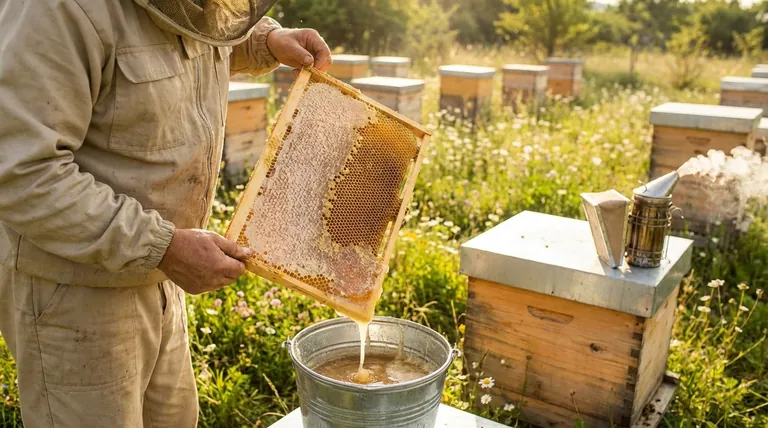In short, yes. It is perfectly safe for most people to eat unfiltered honey. In fact, unfiltered honey is the most natural form of honey you can consume, representing the state of the product straight from the hive, just as it has been eaten for millennia.
The decision between filtered and unfiltered honey is not a matter of safety, but one of preference. It comes down to whether you prioritize the pure, unadulterated state of honey with all its natural components or the clear, uniform liquid found in most commercial products.

What "Unfiltered Honey" Actually Means
To make an informed choice, it's essential to understand what happens—and what doesn't happen—when honey is filtered. This distinction is the core of the difference.
The Commercial Filtering Process
Most honey sold in major supermarkets is finely filtered. This process pushes the honey through microscopic filters to remove all small particles, including pollen grains, tiny air bubbles, and bits of beeswax.
The primary goal of this intensive filtering is cosmetic. It creates the crystal-clear, uniform, and shelf-stable liquid that consumers have come to expect.
The Contents of Unfiltered Honey
Unfiltered honey is simply strained to remove large debris like wax chunks or bee parts. This gentle process leaves the beneficial, microscopic components intact.
These components include bee pollen, which is a source of vitamins and antioxidants, and propolis, a resinous compound bees create that has antimicrobial properties. These are natural parts of the hive environment.
Raw vs. Unfiltered: A Key Distinction
It's important to note that "raw" and "unfiltered" are not the same thing, though they often overlap.
- Unfiltered refers to the lack of fine filtering, preserving pollen and propolis.
- Raw means the honey has not been heated or pasteurized. Pasteurization destroys yeast and can prevent crystallization, but it also degrades delicate enzymes and antioxidants.
For the most natural product, you would look for honey that is both raw and unfiltered.
Understanding the Trade-offs and Considerations
While unfiltered honey is safe, its natural state comes with characteristics that differ from highly processed honey.
Appearance and Texture
Unfiltered honey is often cloudier than filtered honey due to the suspended pollen and other fine particles. This is a visual indicator of a less processed product.
It also tends to crystallize faster. This is a completely natural process where the glucose in honey separates from the water. It is not a sign of spoilage and can be reversed by gently warming the jar in water.
A Critical Safety Warning for Infants
The one major exception to honey's safety applies to all types, whether filtered, unfiltered, raw, or pasteurized.
You should never give honey to an infant under 12 months of age. Honey can contain spores of a bacteria that can cause infant botulism, a rare but serious illness that affects babies with underdeveloped intestinal tracts.
Making the Right Choice for Your Goal
Your personal preference and intended use should guide your decision.
- If your primary focus is maximum natural components: Choose honey that is explicitly labeled "raw" and "unfiltered" to get the full spectrum of pollen, enzymes, and antioxidants.
- If your primary focus is a clear, smooth texture for baking or drinks: A standard filtered honey will dissolve easily and provide a uniform consistency.
- If you are preparing food for a child under one year old: You must avoid all types of honey entirely.
Ultimately, choosing unfiltered honey is a safe and direct way to enjoy this natural sweetener in its most authentic form.
Summary Table:
| Aspect | Filtered Honey | Unfiltered Honey |
|---|---|---|
| Processing | Finely filtered & often pasteurized | Gently strained; may be raw |
| Appearance | Clear, uniform liquid | Cloudy, with visible particles |
| Contents | Pollen, propolis, and enzymes removed | Retains natural pollen, propolis, and enzymes |
| Texture | Stays liquid longer | Crystallizes faster (natural process) |
| Best For | Smooth texture in baking/drinks | Maximum natural health benefits |
Ready to source the finest unfiltered honey and beekeeping supplies?
At HONESTBEE, we supply commercial apiaries and beekeeping equipment distributors with the high-quality tools needed to produce premium, natural honey. Whether you're harvesting raw, unfiltered honey or need reliable equipment for your operation, our wholesale-focused services provide the quality and consistency your business depends on.
Contact HONESTBEE today to discuss your supply needs and discover how we can support your success.
Visual Guide

Related Products
- 0.5T Capacity Honey Dehumidifier Dryer with Vacuum Heating and Thickening Filtering Machine
- Honey Concentrating Vacuum Heating Thickening Machine Dehumidifier for Honey
- Professional Thermostatic Conical Honey Melter
- Honeycomb Style Drip Free Honey Dispenser
- Electric 8 Frame Honey Spinner Extractor Equipment for Beekeeping
People Also Ask
- How does a honey dryer remove moisture from honey? Achieve Perfect Honey Stability with Controlled Drying
- How to reduce moisture level in honey? Preserve Quality and Prevent Fermentation
- What is the recommended drying temperature and moisture content for honey? Preserve Quality & Prevent Fermentation
- How much honey can a honey dryer process and by what percentage does it reduce moisture? Optimize Your Honey Production
- What are the benefits of using a honey dryer for honey production? Boost Yield & Quality



















